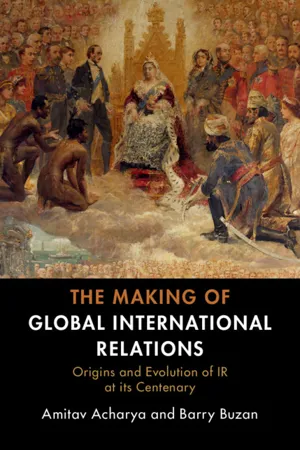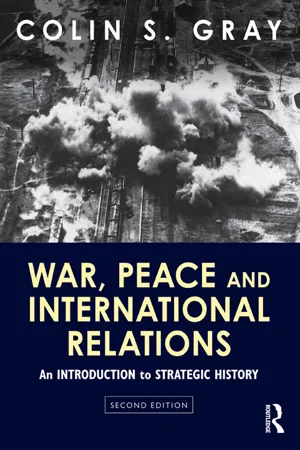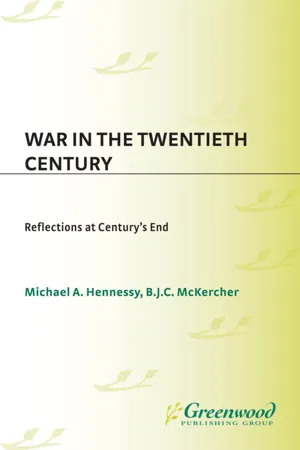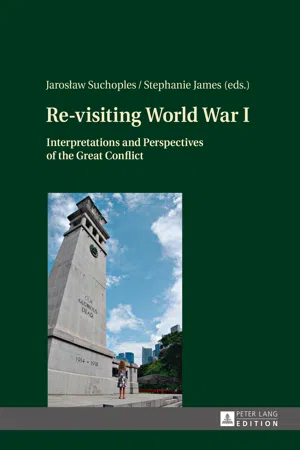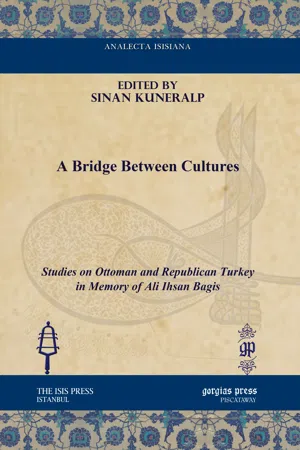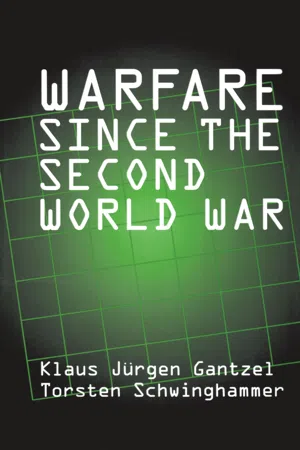History
World Wars
The World Wars refer to two major global conflicts primarily fought in the 20th century. World War I (1914-1918) involved many of the world's great powers and was triggered by the assassination of Archduke Franz Ferdinand of Austria. World War II (1939-1945) was even more widespread and devastating, involving many countries and resulting in significant geopolitical and social changes.
Written by Perlego with AI-assistance
Related key terms
1 of 5
8 Key excerpts on "World Wars"
- eBook - PDF
- Michael Adas(Author)
- 2010(Publication Date)
- Temple University Press(Publisher)
Recent interpretations of the most devastating and widespread wars in history, each one the most “total” war in history to that point, when placed in the broadest possible global con-text, necessarily revise the historian’s perspective of the wars as a whole and require the constant reworking of narratives and arguments. This ongoing pro-cess constitutes the lifeblood of history, occasionally rendering studies and in-terpretations long canonized in the profession questionable and dated. Such challenges to what have become canonical interpretations take time to perco-late through the profession and the general public, and then only to find them-selves in turn revised or replaced by revisionist approaches incorporating even newer information or perspectives. In this essay, I would like to argue for a more comprehensive and interconnected approach to both World Wars that incorporates the latest research in an effort to comprehend the origins, course, and impact of the two most extensive and costly wars in human history and ultimately to suggest new ways in which historians might view these conflicts as part of larger, longer-term historical processes. Distant Origins—The Twin Revolutions The two World Wars represent the culminating point of the twin revolutions that mark the beginning of the modern age—the French and Industrial— which propelled Europe to global domination by the beginning of the twenti-eth century. The French Revolution epitomized the ideas of modern national-ism and popular sovereignty, and the French Republic inaugurated national conscription in 1792, as it resorted to the levée en masse , first to defend against invasion by the armies of the monarchies of Europe and then to spread revo-lutionary ideas through conquest during the wars of the French Revolution and Napoleonic era. By the end of the nineteenth century, liberalism had frag-mented, and monarchical forces had harnessed nationalism as a tool to but-tress their conservative rule. - eBook - PDF
The Making of Global International Relations
Origins and Evolution of IR at its Centenary
- Amitav Acharya, Barry Buzan(Authors)
- 2019(Publication Date)
- Cambridge University Press(Publisher)
67 67 3 The World 1919–1945: Still Version 1.0 Global International Society Introduction The First World War can perhaps best be seen as the first round of a systemic crisis of modernity on a global scale. As we will show in later chapters, subsequent rounds of this crisis (the Second World War, the Cold War and decolonisation, the ‘rise of the rest’) occupied much of the twentieth century. As argued in Chapter 1, the causes of the First World War were generally rooted in the destabilisation of great power relations caused by modernity, and particularly in the destabilisation in military relations caused by both nationalism, and the dynamics of industrial arms racing. The war was not significantly caused by either ideological conflicts about forms of government, or an economic crisis arising out of modernity, though both of those were significant consequences of it. This chapter covers both the interwar years, as a failed attempt to recover and improve on the international society of the core from before 1914, and the Second World War, which was the consequence of that failure. The next section picks up the main themes from Chapter 1, and looks at the continuities with, and discontinuities from, the period before 1914. We argue that the First World War was only a partial crisis of mod- ernity, and that its consequences, though in some ways big, did not fun- damentally change the structure of version 1.0 international society. The following sections look at the main themes of interwar international politics and the Second World War, finding it a much more substantial global crisis than the First. We build towards the argument that the First and Second World Wars and the Cold War, plus decolonisation were not really discrete events, but phases in a more general crisis unfolding from the consequences of the wholesale transformation in international relations generated during the nineteenth century by the revolutions of modernity (Buzan and Lawson, 2015b). - eBook - ePub
War, Peace and International Relations
An introduction to strategic history
- Colin S. Gray(Author)
- 2013(Publication Date)
- Routledge(Publisher)
6 World War I, I
ControversiesReader's guide: Controversies about World War I. The scale of the conflict. Casualties.Introduction: the making of the twentieth century
With black humour, one could argue that the Great War of 1914–18 was the kind of conflict that gives war a bad name. War should be an instrument of policy; Clausewitz is crystal clear on that fundamental. However, once the basic decisions to fight were taken, for four and a quarter years warfare seemed more in command of the policies of states than commanded by them. That was not quite true, but nor was it wholly an illusion. The strategic historian takes serious note of Gary Sheffield's expansive claim that ‘The First World War was the key event of the twentieth century, from which everything else flowed’ (Sheffield, 2001: 221). Sheffield is persuasive, provided one does not take too literally his assertion that ‘everything else flowed’ from the war. One has to beware of such a vague concept as the flow of events – sometimes events seem to trickle lazily, at other times they appear to rest, while they have also been known to reverse direction as in ‘a turning tide’. While there is no doubt that in many vital respects the Great War made the twentieth century, certainly politically and strategically, there is good reason to question the responsibility of the war for all that followed over the next eighty years.It is plausible to claim that the Great War against France which concluded in 1815 had reshaped, even redefined, international politics for at least a half-century. Similarly, it is scarcely less persuasive to argue that Bismarck's wars to unite Germany under Prussian tutelage and for Prussia's benefit reconstructed the architecture of the balance of power. The German Chancellor decisively altered the way that international politics would have to be managed by the great powers. Now the temporal domain of the strategic historical argument needs to be extended. The war of 1914–18 was uniquely responsible for setting the stage for, and thereby enabling, the major political and strategic events of the century that followed, but even the most influential of historical episodes, which tend to be strategic in character, do not drive forward along predetermined linear paths. Two fallacies beg for attention. - eBook - PDF
War in the Twentieth Century
Reflections at Century's End
- Michael A. Hennessy, B.J.C. Mckercher, Michael A. Hennessy, B.J.C. Mckercher(Authors)
- 2003(Publication Date)
- Praeger(Publisher)
Organization was needed—but of a very different kind. War in the Twentieth Century 23 THE PSYCHOLOGICAL LEGACY OF THE TWO World Wars So far as the bulk of writing on war in this century is concerned, the experience of the two World Wars dominated thinking for at least three quarters of the century. Both wars exhibited ideological as well as national-imperial agendas. Analysis is complicated by the limited and disputed recognition by various schools of analysis of the concept that the antagonists in both wars, especially Germany, the United States, and the Soviet Union, were states in which nationalism and ideology were so interlocked at the governmental level and in the perceptions of an indeterminate but substantial section of their leading elites that patriotic values were expressed in ideological terms, and vice versa. Less attention has been paid to those smaller bilateral wars that occurred before 1914 and between the wars such as the Russo-Japanese war of 1904-1905, the Balkan Wars of 1912-1913, the colonial wars in the Moroccan Rif and of Italy against Ethiopia, the Chaco war in South America, the Saudi war against and capture of the Hejaz, and the various pieces of British "im- perial policing" as against the "mad Mahdi" in Somalia and the rebel- lious tribesmen in Iraq and on the North-West Frontier of India. The civil wars in Ireland from 1919 to 1924, the civil wars in China, and the con- flicts following on the extension of Kuomintang rule into northern China and Manchuria have also to be included. There is also substantial disa- greement between national historiographies as to when the Second World War can be said to have begun, from the Chinese date of July 7, 1937, to that once favored by the catalogers of the Library of Congress, that is, December 7, 1941. - eBook - PDF
Belligerents, Brinkmanship, and the Big Stick
A Historical Encyclopedia of American Diplomatic Concepts
- John M. Dobson(Author)
- 2009(Publication Date)
- ABC-CLIO(Publisher)
201 SECTION 4 THE WORLD W ARS, 1914–1945 When relations among the major European nations broke down in the fall of 1914, their confrontation quickly became known as the Great War. It was only after World War II broke out in the late 1930s that the earlier conflict became known as World War I. That des- ignation was appropriate, because sev- eral of the warring nations possessed extensive overseas colonies. The fighting quickly spread to Asia and Africa, but for some time the Americas appeared to be immune. A key reason was that the United States, the most powerful nation in the Western Hemisphere, immediately announced a policy of neutrality. That assertion did not prevent economic ties from drawing Americans into a major supporting role for Great Britain and France. Emotional and historical factors strengthened the transat- lantic bond, but Germany’s announcement of unrestricted submarine warfare early in 1917 proved to be the tipping point. In April, President Woodrow Wilson obtained a war declaration from the U.S. Congress and began planning the dispatch of an American Expeditionary Force to aid the embattled Allies in Europe. To clar- ify the U.S. position in January 1918, Wilson announced the Fourteen Points, a blueprint for a postwar settlement that he hoped would ensure an end to all wars. After the defeat of Germany and Austria, Wilson’s formula served as the starting point for negotiations. Many alterations and compromises were made in the course of drafting the final peace treaty at Versailles, but it did include a Covenant for a League of Nations. Wilson optimisti- cally believed that this international col- lective security organization would preserve world peace. Among the many issues that the Versailles Conference failed to resolve was the status of the Soviet Union. Two revolutions had swept the Russian Empire in 1917, and the second installed a dedicated communist regime that most Americans considered antithetical. - eBook - PDF
Re-visiting World War I
Interpretations and Perspectives of the Great Conflict
- Jaroslaw Suchoples, Stephanie James(Authors)
- 2016(Publication Date)
- Peter Lang Group(Publisher)
At present, World War I seems to be closer to the present than ever before. Experts still find one hundred tons of materials on the former battle-fields every day. 1 More importantly, politicians who have been confronted with the challenge to quell ethnically motivated violence have recently emphasized basic similarities be- tween the constellations of 1914 and 2014. However, they and some journalists, as well as academics, have ignored or minimized fundamental differences such as the experience of the two World Wars in the ‘age of extremes.’ Moreover, institutions and mechanisms of crisis solution have considerably expanded since 1914, not least by close collaboration between governments in international organizations and forms of transnational cooperation. Most prominently, the United Nations and the Organisation for Security and Co-operation in Europe have repeatedly 1 Gerd Krumeich, “Ein Kriegsmuseum für den Frieden. Das Historial de la Grande Guerre in Péronne,” Geschichte in Wissenschaft und Unterricht 63 (2012): 656. Arnd Bauerkämper 188 mediated in armed conflicts since 1945, although national sovereignty is still reigning supreme in international politics. Not least, decisions for war have to be justified much more convincingly these days than one hundred years ago. The experiences of World War II, in particular, have called into question traditional glorifying views of war as a heroic fight. Nevertheless, warlike attitudes and bellig- erency had by no means vanished by 1945, as the post-war conflicts (for example in Korea, Vietnam and Yugoslavia) clearly evidence. 2 Recent academic debates have once more concentrated on the intricate issue of guilt and responsibility for the outbreak of war. - eBook - PDF
A Bridge between Cultures
Studies on Ottoman and Republican Turkey in Memory of Ali Ihsan Bagis
- Sinan Kuneralp(Author)
- 2010(Publication Date)
- Gorgias Press(Publisher)
Some even consider the Spanish civil war of the 1930s to be the dress rehearsal for WWII, democracy and fascism trying their weapons and warfare methods towards the war of 1939-1945. Furthermore, the Iraq-Kuwait war (1990-1991), and the consequent Gulf War — apparently an inter-state war — was defined by Baghdad as a domestic conflict, the pretext being the secession of Kuwait (the 19th province) from Iraq sometimes in the past. Iraq thus acted to quell and restore a rebellious province, purely an internal issue. Iraq was defeated in this domestic conflict, i.e. in her attempt to liquidate Kuwaiti independence. Russia has been more fortunate and won its domestic conflict with Chechnya, i.e. Moscow has managed to thwart the Chechen people secessionary attempt to separate from Russia. Since WWII there has been a dramatic increase in the eruption of domestic and ethnic conflicts and other sorts of civil strife, some 1000 cases since 1945, without including countless rebellions and coups. The phenomenon increases sharply as we approach the end of the 20th century. Overall, this is a state of affairs unlike the 19th century, when most conflicts were inter-state wars. The turning point was WWI and the years that to follow: coinciding with colossal international wars, there were equally huge civil wars in Russia, China, Spain, with the massive involvement of foreign forces therein. As we progress into the 20th century, the causes for international conflicts appear to diminish. Borders are clearly defined and recognized, however reluctantly. Even Germany recognizes the Oder-Neisse rivers as its eastern border. Likewise, the post-colonial world acknowledges its borders, however surrealistic some of them seem to be. Let us recall that matters were not so after the Treaty of Versailles, which drove Europe to clear madness with the demarcation of new borders. - eBook - ePub
- Torsten Schwinghammer(Author)
- 2018(Publication Date)
- Routledge(Publisher)
2Definitions and Inclusion Criteria for the List of Wars Since the Second World War This chapter defines war and sets out the inclusion criteria upon which we base our list of wars from the end of the Second World War through 1992.Although the first of these wars—the first Greek Civil War—began on December 3,1944, and thus technically predates 1945, it nonetheless belongs to the new epoch emerging out of the Second World War and accordingly shares its symbolic significance. In order to avoid statistical bias and to maintain the symbolic caesura of “1945” we portray the first Greek Civil War unless otherwise noted as beginning in January of 1945 and extend it Actively 29 days after its actual end on February 12, 1945.2.1 Definition of “War”
Following István Kende (1982a:5f) we regard any violent mass conflict which includes all the following characteristics as war:- Two or more armed forces take part in the fighting and at least one side is composed of regular government troops (military, paramilitary groups, armed police units).
- A minimum of centrally directed organization of both warring parties must be present, if only as organized armed defense or strategic/tactical attacks (guerrilla operations, partisan war, etc.).
- The armed operations must have continuity and not be only occasional, spontaneous clashes. This means both sides must follow a planned strategy whether the fighting takes place on the territory of one or several societies and regardless of the length of the conflict.
In contrast to Small and Singer (1982), among others, our definition does not initially differentiate between international and intranational wars.1
Index pages curate the most relevant extracts from our library of academic textbooks. They’ve been created using an in-house natural language model (NLM), each adding context and meaning to key research topics.

